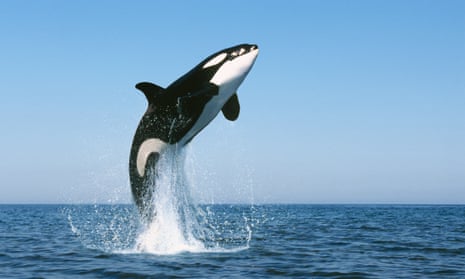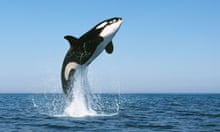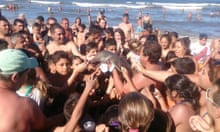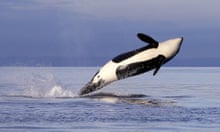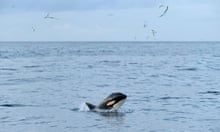The body of Lulu the killer whale was found on jagged rocks on the Isle of Tiree in the Inner Hebrides. A member of the only pod found in British waters, she had died last year after getting entangled in fishing lines.
It was a sad discovery, especially as a post-mortem revealed Lulu had never produced a calf. But the recent autopsy also revealed something else; something that is alarming marine experts and which offers a bleak, damning judgment on the state of Britain’s coastal waters. Lulu’s body contained among the highest levels of a particular type of man-made chemicals ever recorded – more than 100 times above the level that scientists say will have biological consequences for a species.
Few will have heard of PCBs – or polychlorinated biphenyls. The chemicals were banned in the late 70s amid fears about their toxicity. Recent estimates suggest that Europe produced anything between 299,000 and 585,000 tonnes of PCBs. The US produced even more.
But while industry has stopped using PCBs in the manufacture of everything from transformers to thermal insultation to paints and adhesives, millions of tonnes of the chemicals continue to be in circulation. It is only now that their enduring and pernicious impact is being understood, as support for a clean-up, along the lines of successful experiments in the US, is taking hold.
“If we go back to the late 70s or early 80s, there were major campaigns from organisations such as Greenpeace focused on what they called toxics – which included PCBs,” said Mark Simmonds, senior marine scientist at the Humane Society International.
“There was a tremendous effort to get them under control and banned and those bans were effective – the levels of PCBs being detected have clearly declined and so the campaigning organisations packed up their tents and went off to look at something else and we all kind of rejoiced and thought this was a major environmental victory.”
But Simmonds now believes the victory was, to some extent, hollow. While PCBs are no longer being produced, they are extremely hardy, given that they were designed to resist extreme heat. Guidance from the US Environmental Protection Agency explains that PCBs do not readily break down once in the environment. “They can remain for long periods cycling between air, water and soil. PCBs can be carried long distances and have been found in snow and sea water in areas far from where they were released into the environment.”
“It’s a difficult problem,” said Simmonds. “The PCBs are coming from two places – from buildings and materials that are still being destroyed and dumped, resulting in a new release of PCBs into the environment. And PCBs are also getting recycled into the wider environment through activities such as dredging programmes in estuaries.”
Ultimately, PCBs find their way into the food chain. “PCBs on land eventually get into the water course,” said Paul Jepson, a veterinary specialist in Wildlife Population Health at the Zoological Society of London. “Then they get into rivers, then into fish, then into sediment, then into estuaries then to ocean, the ultimate dump. Then they get into crabs and moluscs, then into fish, then into bigger fish and finally into apex predators such as sharks and killer whales at the top of the food chain.”
Emerging evidence of the pernicious impact of PCBs may explain why there are no great white sharks in British waters. “We should have great white sharks around the UK,” Jepson said.
“There’s no reason not to have them. Our seal population has been growing for years, there’s plenty of food and they used to be here; they were almost as widely distributed as killer whales, historically but, when did anyone see a great white shark in recent years off the UK or the north east Atlantic?”
Simmonds believes the impact of PCBs may explain the absence of other species from British waters. “As we look around the UK historically, we would have expected to see bottle-nosed dolphins in any of our estuaries,” he said. “We have them in Cardigan Bay and the Moray Firth and a few around Cornwall and Devon – but it’s very much a reduced population from where it should be. There are many different factors affecting them but one of the key things is probably PCBs repressing their reproduction and making them more vulnerable to infection.”
Equally vulnerable are polar bears, which ingest PCBs when they feast on seals. And, like killer whales, the bears can transfer PCBs to their offspring through their milk. Killer whales have an 11-month lactation period during which they produce very high fat milk for their calves. The higher the fat, the easier it is for PCBs to dissolve in it.
Unsurprisingly, then, some of the highest concentrations of PCBs recorded have been in newborn killer whales. Post-mortems conducted on some six-month-old calves found they had absorbed about 80% of the PCBs that were in their mother.
A scientific paper by Jepson and his colleagues, published last year, reveals that PCBs were found in every single one of 1,081 dolphins, porpoises and killer whales they studied. Of these – about 55% of the harbour porpoises, most of the striped dolphins and bottlenose dolphins and all the killer whales had high levels of PCB – levels that were greater than 9.0 miligrams of PCB per kilogram of their lipid or body fat. It is above this level that races of PCB can have biological consequences for certain species.
But many killer whales have far higher concentrations – typically between 10 and 100 times above the 9mg/kg threshold. Lulu had PCBs measuring 957 mg/kg lipid.
At these levels, species stop reproducing, Jepson said. This probably accounts for why Lulu’s pod produced no calves – the nightmare scenario. Ultimately, if species stop reproducing they become extinct.
“You’d put it (PCBs as a problem) up there alongside the hole in the ozone,” Simmonds said. “Something that can knock the top marine predators out – that’s a pretty major problem. As an old toxics campaigner, this is something that I thought we’d fixed. And, to some extent we did, but it turns out it wasn’t fixed well enough. There are lessons to be learned from this. We have to maintain vigilance about environmental problems and not rest on our laurels.”
Studies coming out of the US are now considering what impact, if any, PCBs, may be having on human health.
“In the US there is a lot of scientific evidence showing the toxic effects of high PCB human health but this approach has yet to be replicated in Europe,” Jepson said.
The EPA website acknowledges: “People who ingest fish may be exposed to PCBs that have bioaccumulated in the fish they are ingesting.”
Tackling the problem is a daunting prospect. The chemicals can be destroyed only in high temperature incinerators which are found in only a few countries. There are some 40m tonnes of PCBs known to be in circulation. Estimates suggest that destroying them could cost anything up to $70bn.
And this is before old tower blocks and industrial buildings – rich sources of PCBs – are demolished, adding to the pile. “Only Norway, Sweden, and Switzerland have established procedures for secure disposal or destruction of highly contaminated PCB in joint sealants (a major PCB source in buildings) in Europe,” said Jepson, who is nevertheless optimistic that something can be done.
“We are winning this argument. Papers (identifying the problem) have only come out in the last few years in Europe and are new to a lot of people but in the US this is very widely accepted. They’ve been dealing with PCBs for decades. Americans have been spending billions and billions of dollars to clean up rivers and estuaries.”
Major polluters have been made to pay for the clean-up. One site, in the Hudson river, was largely paid for by industrial giant General Electric.
“We urgently need a similar approach in Europe,” Jepson said. “It’s been done mainly to protect human health, but there’s a wonderful side-effect. A lot of wildlife is now slowly coming back including seals, seabirds and bottlenosed dolphins and harbour porpoises. On both the east and west coasts, the great white is also recovering. Only killer whales are still doing badly but if the US carries on the way it has been doing, then I think killer whales will make a recovery as well.”
